#--hanging around a planet a couple million miles away and the same goes for the rest of the court) there is Some level of familiarity--
Explore tagged Tumblr posts
Text
my animals <3
#sorry i am actively trying to force a good mood by thinking abt smth that is dear to me. ik im being annoying abt it im sorry#with the divine court being a radiating spectrum of one group of guys cast out across All of existence (like. belrath is a prism and there--#--are Shades of him across everywhere if that makes sense. the belrath hanging around alamanni is the same but not as the belrath--#--hanging around a planet a couple million miles away and the same goes for the rest of the court) there is Some level of familiarity--#--betwesn them and the constantly spreading eldritch beasties. a bit of a 'you do your thing and we do ours and we will only interfere if--#--you REALLY get in our way' type deal. a somewhat tense neutrality
2 notes
·
View notes
Text
LGBTQ VN Week: Day One! (6/18)
Welcome to the first day of my LGBTQ visual novel recommendation week, in honor of Pride Month 2018! Every day from today (June 18th) to Sunday (June 24th), I’ll be talking about four visual novels with LGBTQ themes, characters, and/or creators that have stood out to me and explaining a little bit about why I like them! I also reached out to a handful of those VNs’ developers and talked with them about their work, so you’ll be seeing a casual interview tagged onto the end of every post, too. ✨
To kick things off today, I’m highlighting four visual novels that are practically bursting at the seams with personality, all in their own ways — Saturn’s WORST DATING SIM, Obscurasoft’s Coming Out On Top, Brianna Lei’s Butterfly Soup, and Madeleine’s Inverness Nights!
Hit the jump to read about watching Animal Planet with punks, beta-testing hookup apps, Mario fire alarms, and why it is that so many visual novels seem to use character archetypes.
One note before we get started! This list isn't meant to be reflective of "the objectively best LGBTQ visual novels" or anything like that, which I want to be ultra-clear about upfront. It's not a list of all the ones I've ever played, either. There are plenty of visual novels with LGBTQ characters/themes that have been recommended to me frequently — while I was working on this list and over the past couple years — that didn't make it onto this list because I couldn't afford to buy them, or because they just weren't for me when I did buy them, or because of a million other reasons.
To give an example of this in action: I barely have any originally-Japanese language visual novels on here, because the number of M/M ones that get translated is already so low and already nearly 100% commercial, and I'm way more inclined to pay for M/M than anything else. (Reason: I'm gay and I like looking at hot guys.) For the purposes of this list specifically, I've also cut out a fair few BL-marketed VNs — from both Western and Eastern developers — that skirt around the issue of whether or not the protagonist is gay/bi/etc awkwardly.
I also tried to limit myself to one VN per team, picking the ones I thought were best representative of their output and leaving space to mention other works of theirs that I'd liked, with the aim of keeping this list from being totally dominated by studios who'd put out a lot over a long period of time. And then personal taste for other genre and content details comes into play, so it cuts out even more from what's left! In the originally-Japanese BL category alone, that left me with a single nominee, which was... Well, you'll see!
Basically, I went over a lot of different options to settle onto a list that's ultimately only supposed to be things that I, personally, would recommend! And I don't want to recommend things I didn't enjoy, one way or another. Nobody wants to sit through multiple paragraphs of a slog where I'm trying to talk about a game I didn't actually like (or, in plenty of cases, a game I couldn't afford) without acknowledging that I didn't like it. To be totally honest, that sounds like it would suck to try and write.
So if your favorite LGBTQ visual novels aren't on here, but you want to give people an excuse to play them, I'd love to read anyone else's personal recommendation lists! I'm not a journalist or a reviewer and this isn't anything close to a formalized games review blog that I'm planning to update ever again; I'm just a VN dev who felt like sitting down and making a list of other LGBTQ VNs I liked one day, so I went and I did it. And I felt like giving those other devs a platform if I was going to talk about their work, so I took my own Patreon earnings to pay for as many as I could, then I went and did some interviews, too.
Thanks for sitting through (or skimming, as the case may be) that wall of text! Without further ado, let's talk WORST DATING SIM!

WORST DATING SIM (SATURN)
Itchio Tagline: “MRGRGR.” Genre(s): Slice of life, shitpost. Release Date: January 22nd, 2018. Content Warnings: Brief depiction of blood; violence.
Out of all the visual novels I’ll be covering over the next week, WORST DATING SIM is the only one I haven’t seen nearly all the content for, and not for a lack of trying! Saturn’s debut visual novel, a challenging conversational simulator where a punk named Etsuji decides to follow you home and hang out with you purely because he can, features a grand total of 69 ways you can get a GAME OVER. By and large, these endings come at the hands of your newfound friend (?), who’s got a temper and a sensitive streak a mile wide. If Etsuji doesn’t like what you’re saying, he’ll knock your lights out, and you’ll get booted back to the title screen.
The way WORST DATING SIM doubles down on this challenge is by intentionally removing Ren’Py’s default save feature — if you piss Etsuji off, you’re back at square one, period. You have to either somehow retain the information yourself or turn to someone else’s successful run for help, because it’s deliberately designed to be done in a single playthrough without reloading. Even a fair few jokes in the script, like “I’m sure in several alternate universes he’s punched my lights out, but so far I’m safe,” are dropped in to acknowledge the fact that beating WORST DATING SIM is more akin to powering through a run of Getting Over It with Bennett Foddy. (But don’t worry, the Skip Text function is still there to help you out!)
As someone who does turn to guides frequently to find out what I’m missing on my third or fourth playthroughs of visual novels, I assumed from the start that at some point that I’d want to find a walkthrough in order to see any real endings. But the sheer charm of Etsuji’s responses and, to be completely frank, how much fun I was having just trying to scale Etsuji’s emotional mountain meant that I never really hit that point while playing. WORST DATING SIM’s distinct personality struck exactly the right chord in my brain that made me want to keep playing by myself, tunneling away at it persistently, and it made the ending(s!) feel all that much more rewarding.
WORST DATING SIM is available now for free on Itchio, and you can follow Saturn on his Itch.io or Twitter (NSFW) for updates on more potential WDS content or his other upcoming visual novels.
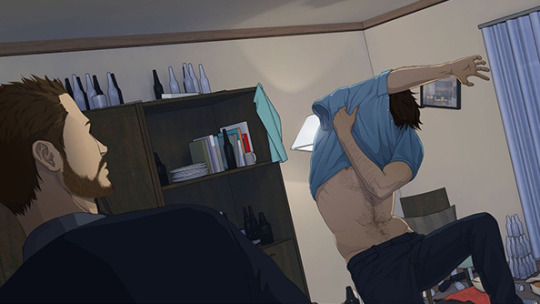
COMING OUT ON TOP (OBSCURASOFT)
Itchio Tagline: “The erotic comedy gay dating game that'll make [you] laugh, cry, and get a little boned up! Hot dudes included.” Genre(s): Comedy, romance. Release Date: December 10th, 2014. Content Warnings: Nudity; mentions of homophobia; sexual content; seriously there’s a lot of sex in this.
If you’ve played M/M dating sims in the English language sphere any time in the last five years, you’ve probably heard of Obscurasoft’s Coming Out On Top — drawing more from the Western tradition of porn by and for gay men than anything else, it tells the story of newly-out college senior Mark Matthews and his run-ins with hot guy after hot guy (after hot guy, after... you get the picture). With the help of his roommate Penny, he also takes on the hookup app scene and delves into a sea of bonus dates funded by Kickstarter backers, which were released steadily from January 2015 to December 2016.
Coming Out On Top’s steady stream of humor never goes so far as to be totally derailing from its focus on sexuality and Mark’s genuinely sincere approach to relationships, casual or otherwise; Obscurasoft manages to infuse the numerous sex scenes with enough awkwardness, humor, and personality that actually playing through them back-to-back feels less like a string of pinups and more like scenes Mark is actively involved in or growing from. As a character, especially one whose archetype has gotten a lot of mileage in gay porn since the dawn of mankind, it’d be narratively easy to let Mark remain a generally undefined slate for players to project themselves onto.
And while there is a degree of personalization, especially when it comes to how blatantly horned-up some of the dialogue is compared to other options the player can choose, Coming Out On Top is still very distinctly Mark’s story. His specific insecurities from years of being closeted don’t vanish as soon as he comes out, and hookups don’t always work out for him the way they might in ten minute long “first time” AVs. His grades still matter, and his friends still exist, and he’s still got his own sense of priorities the player can disregard (at their own fish-related peril) or see through on the slow climb to the end of his senior year.
Coming Out On Top is available now for $14.99 on Itch.io, and Obscurasoft’s website; to get early updates about what they’re working on next, you can follow their News & Updates blog or their Twitter.

BUTTERFLY SOUP (BRIANNA LEI)
Itchio Tagline: “Gay girls playing baseball and falling in love.” Genre(s): Comedy, slice of life. Release Date: September 16th, 2017. Content Warnings: Parental abuse; violence; racist language; homophobic language; ableist abuse and slurs.
The strength of Butterfly Soup’s personality, from beginning to end, is founded in its four point-of-view characters — kindhearted Diya, reckless Min, sharp Noelle, and carefree (?) Akarsha. As a group of ninth grade friends with different priorities and different reasons for joining their shared baseball team, which are as obvious as the hugely-varied color schemes of each girl’s clothes, they play off of one another easily. Lei uses her fair share of actual memes, but never ones that feel like the speaking character — usually Akarsha — wouldn’t say them, which holds true to the rest of Lei’s dialogue writing. It feels distinctly ninth grade without ever being mocking or trivializing the way everything is so extremely important all the time when you’re a ninth grader.
Part of that strength definitely comes from Lei’s willingness to lean on each character’s archetype and unpack it at the same time; Diya’s physical strength and sheer skill, combined with her reluctance to talk to strangers, could have easily seen her shoehorned into a much more detached character than she’s written as. Instead, she’s thoughtful, expressive, and deeply concerned with the people she cares about, even if she can’t always necessarily communicate that to them very well through her ever-present anxiety. Exactly how their own differences manifest and each of the three other girls’ reasons for being that way are slightly trending into spoiler territory, but I think Diya’s fellow main characters also each have their own similarly-smart tweaks on familiar archetypes that make their joke-filled banter all that much more personalized and memorable.
Although there’s a lot to love about the positive, hilarious moments in the protagonists’ everyday lives, one of the things that I think worked just as well narratively were the scenes that required all those content warnings up there. They're very much going to be a YMMV situation for different players, especially with my own caveat that my relationship to dysfunctional families is coming from white Irish ex-Catholicism rather than those two specific Asian cultures’ values — trying not to give any spoilers about which characters I’m referring to, here! — but in-text, they’re never situations without any future, because we can see that future where the group has each other, and they always have room in the moment to be angry, or upset, or hurt without the narrative itself punishing them for failing to be perfect. Instead, they get to play baseball and fall in love and set off fire alarms, and they do pretty okay.
Butterfly Soup is available now for free, and you can follow Brianna Lei on Itch.io, Twitter, or Tumblr to learn more about her upcoming work.
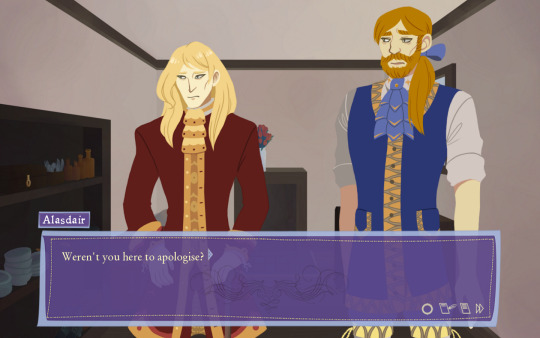
INVERNESS NIGHTS (MADELEINE)
Itchio Tagline: “Every relationship ends.” Genre(s): Historical fantasy, drama. Release Date: June 30th, 2017. Content Warnings: See Itch.io page.
There are a lot of things about Inverness Nights that worked for me in a way I don’t know that they would have in another visual novel — in particular, Tristram’s character is difficult in ways that pretty directly pertain to some of the content warnings linked above, and I was personally interested in seeing the text unpack that bit by bit. The eventual turn the story takes further on in your playtime, to try and phrase that in a way that isn’t super spoilery, was something I personally didn’t mind taking a little longer to get to.
Curious to hear what its developer Madeleine had to say about the story, their thoughts on character design, and what they’re up to next, I reached out to them for an interview!
IVAN: Thanks for having me, Madeleine! To get this conversation started, how would you sum up Inverness Nights to everyone reading this?
MADELEINE: Inverness Nights is a game about queer isolation and the importance of queer community outside of romantic relationships. Set in 18th c Scotland you play as Tristram Rose, an immortal gay man who has just broken up with his mortal boyfriend, and decide how he’ll cope with the loss as someone unable to tell the world around him that he’s magical and queer.
Sounds spot-on! And definitely a great summary of all the things that made it super appealing — to me, at least, haha. Before anything else, I want to note that it's been just about a year since you released Inverness Nights! Congratulations! How's the experience been, and what particular highlights or lowlights over the past year stand out to you?
It was good actually releasing a game, I enjoyed that part a lot! Aside from that, I really appreciated a couple of thoughtful reviews it got where people connected with it as a game where being queer is difficult, but not bleak. I think that because AAA games love tragic gay stories indie games can sometimes feel they need to be ultra-positive to balance that in the other direction, which is cool, but as someone who likes stories that’re more in-the-middle it was a gap I wanted to fill. There was a good reaction to that, albeit a quiet reaction. It’s a very ‘first game, niche game’ complaint but the lowlight would probably be that not many people played it — however, there are a lot of understandable reasons why it worked out that way so I’m not too hurt overall.
Haha, getting something finished and released is definitely a great feeling; I'm personally really glad you stepped in to fill that niche, as someone who likes things that are honest about their characters' pain without feeling exploitative or endlessly hopeless! In the fantastic (but spoiler-filled) Medium postmortem you wrote on your process, you say that "an important part of marketing visual novels is selling your characters"; the postmortem goes into that in fairly great detail, especially as it pertains to ensemble casts, but would you care to expand upon that observation in the scope of the visual novel genre (and how you're keeping it in mind for future projects) a little bit here?
People make fun of visual novels sometimes for their reliance on archetypes — you know, look up the average dating sim and you can probably tell in an instant who the bad boy is, who the smart girl is, so on — but when you’re selling a character driven game to people, you can’t give away the cast’s backstories and quirks up front or there’s nothing to play for, so you’ve got to find some sort of shorthand to suggest what an audience wants will be there, and that usually comes back to telling them which archetypes you’ve got. When I started Inverness Nights I kind of laughed at that reliance on archetypes and tried to do something different but I learnt the hard way why it’s important. At the moment I’m finishing a game called Catacomb Prince with my didn’t-quite-finish-it-for-a-jam group Skeleteam, and when our character artist Roxy was doing the designs I gave her very broad notes on who the cast were so they’d be more archetypical. Consequently we have a very recognisable cool girl/frat boy/petite NB slate of romance options that people’ve connected with waaay more easily and way faster than anyone did with the IN cast, which I think speaks to why it’s a sound approach.
I definitely agree in the importance of finding a good balance with archetypes; I've had people who've instantly bonded when I invoked "shy genius" or "lovestruck best friend", which ironically has given me a bit more of that freedom in telling their stories more uniquely! Could you shed a little light on what Catacomb Prince is, without too many spoilers, and what your storytelling influences for a visual novel like that have been?
Catacomb Prince is a Gothic comedy; you are Prince Vitali, trashy heir to a fantasy Renaissance kingdom, and you have woken up dead five years after a raging party. Your parents still expect you to inherit the throne despite your new skeletal appearance, but your kingdom’s laws require the King to be married. Find love, find your killer — or die again trying.
It’s mostly inspired by Animamundi: Dark Alchemist, which is an old kitschy BL VN about a guy named Georik taking up alchemy to make a new body for his decapitated (still living) sister while hiding his hobby from his friends. Animamundi has some very gloomy stuff happening but it’s so over-the-top about it that it loops around to being a very funny game, and I wanted more experiences like that in the world, so here we are. There’re also some aspects of other goofy Gothic stories in there, like Hammer Horror movies and EC Comics, though the romance aspect of it means it’s not all rib-ticklers all the time. We took care to make the love interests more than just fodder for jokes and/or horror. They’re complete, kissable people, with flesh and everything.
I am not doing a good job of easing up on the skeleton jokes but please believe me on that last point.
Glad to hear the love interests have skin! Not super fussed about that, personally, but I'm sure some players would have logistical concerns about things like skeleton-on-skeleton kissing. (I'd like to go on the record and say I'm pro-skeleton and extremely pro-skeleton puns, so I'm waiting with bated breath to get to play as your not-breathing protagonist.) Other than what we'll be seeing in Catacomb Prince, what kind of genres and themes are you interested in exploring more of in the future?
After Catacomb Prince I’m going to work on finishing an IF game I started last year called Captain Dracula, about being the last survivor on a submarine after your Captain reveals he’s Dracula. That’s also a comedy. I spent three years making Inverness Nights so taking a breather to make funny games for a while seemed like a good plan, and I’m really into classic horror, so I’ve gravitated in that direction with it. I’ve also got a regular no-pictures no-choices fantasy novel I’m several drafts through at the moment which I’ll hopefully be releasing later this year. Once those’re off my plate, I’m keen to try making either an 80 Days-style narrative travel game or a Clock Tower-style point-and-click horror for a change of pace. I want to do something that’s more about exploring a place; I do academic stuff as well as indie development and all my academic work has been on how we explore places in games, so it feels weird that I haven’t made anything that utilises my research.
It sounds like you've got a lot coming up! I'm looking forward to seeing how you can combine your academic studies with your fiction work, which already have such strong settings of place from the get-go. And last but not least, what LGBTQ visual novels from other developers would you like to recommend?
It's IF rather than a VN but I love Heart of the House by Nissa Campbell, which is a Gothic game about an exorcist trying to remove an evil presence from a Victorian manor house, and maybe also wooing some of its residents. It’s very atmospheric and you can be NB, two things I like a lot. With caveats I’m also really keen on Animamundi (like I mentioned earlier — fun, funny MLM but warning for violent horror elements and sexual abuse), and The House in Fata Morgana (a dark romance about a trans man trying to rescue his girlfriend from a cursed manor, there’s an extensive content warning list on its website). Lastly, on the lighter side, Butterfly Soup and The Duenkhy are both good VNs about queer people making friends :) probably play them when you need to smile after all the grimmer suggestions I’ve made.
Awesome — and thanks again for your time, Madeleine! It was a pleasure.
Inverness Nights is available now for $12 USD, and you can follow Madeleine on Twitter or Itch.io to keep up with all the skeleton romances and Dracula adventures they're setting their sights on next!
Thanks to everyone who read this far! Keep an eye on the Twitter thread or this blog for tomorrow’s post, where I’ll be talking about four more visual novels that I think do some crafty things with their creative design!
28 notes
·
View notes
Text
Saudi Arabia Wants Your Next Vacation
AL-UYAYNAH, Saudi Arabia — In a makeshift camp under a starry sky, Ghazi Al-Anazi talked about his experience in the fledgling Saudi tourist business. A decade ago, barely in his 20s, he started taking British business associates of his brother to see the wind-carved hills of the Saudi desert.
Now 31, he has a small fleet of S.U.V.s, nearly a dozen employees and a self-taught ability to cater to the whims of visitors from many nations.
“I know what they want to do, and what I need to do about it,” he said, ladling out a dinner of barbecued chicken and Middle Eastern salads to a couple of dozen tourists from France, Ukraine, Malaysia and the United States.
Mr. Al-Anazi and his business, Ghazi Tours, take up to 900 visitors a month on treks like this one to a dry riverbed dotted with venerable acacia trees north of Riyadh, the Saudi capital.
But he’s confident those numbers are about to multiply, as Saudi Arabia begins to open itself up as a major tourist destination. The government recently began issuing tourist visas for the first time, a remarkable shift for a traditionally shuttered society.
And it goes far beyond that: Billions of dollars are being poured into vast tourism projects throughout the kingdom, from flashy resorts to new airports, in a bid to shift the economy away from its dependence on the petroleum industry and the government jobs it finances.
Visiting Saudi Arabia has long been a difficult proposition for everyone except Muslim pilgrims going on the hajj and business travelers. For decades, historic sites have been largely ignored, and hotels and travel services were scarce outside major cities.
Unemployment among Saudi nationals is stubbornly high, about 12 percent. But the government figures that the travel industry, which employs about 600,000 people, can be expanded to create up to a million more jobs, as the need for everything from drivers, chefs and guides to hotel managers and archaeologists expands.
The move toward tourism was devised by Crown Prince Mohammed bin Salman, the kingdom’s 34-year-old chief policymaker, whose Vision 2030 program seeks to diversify the economy, draw in more outside investment and expand the private sector.
The Saudis are hiring international real estate executives and introducing elaborate advertising campaigns to try to put themselves on the map. Already, there are signs the push is paying off: Saudi hotel room sales in the first nine months of 2019 increased 11.8 percent from the same period last year.
But a question hanging over the whole initiative, some travel experts say, is how many people will want to visit an ultraconservative kingdom that’s the subject of intense criticism over its treatment of dissenters and women, that restricts the use of alcohol and until recently barred unmarried couples from sharing rooms.
An effort to overcome those concerns by inviting social media influencers for expense-paid trips this year prompted a backlash by online commenters.
Saudi Arabia is promoting a different image: ultramodern resorts, ruins from ancient civilizations and romantic desert landscapes once crossed by Lawrence of Arabia. And tour guides won’t object if you want to take a selfie with a camel.
Referring the vast golden vistas, “I call it the new yellow oil,” said Amr Al Madani, the chief executive of the Royal Commission for Al-Ula, a region in the northwest part of the kingdom that is roughly the size of New Jersey.
Al-Ula includes the evocative ruins of an ancient city of carved rock tombs, called Mada’in Saleh. Like Petra, a popular tourist draw in southern Jordan, the city was built by the Nabataeans about 2,000 years ago.
The vast region has only 45,000 residents. There are some existing resorts, and France’s Accor chain recently agreed to manage one. Mr. Madani is planning an investment of up to $20 billion, from a mix of public and private sources, to finance airport expansion, hotels and other facilities to accommodate up to two million visitors drawn to archaeological sites as well as food and cultural attractions.
An even more ambitious scheme is under construction on Saudi Arabia’s western coast. The Red Sea project covers a remote area with 120 miles of coastline, more than 90 islands and extensive coral reefs that could one day be a diving and snorkeling paradise.
The Saudis want to put four dozen luxury hotels there, including 14 in a first phase, forecasting that these facilities will eventually contribute around $6 billion a year to the economy. Accor has agreed to participate, and the developers say they are in talks with other international hotel groups.
The Public Investment Fund, Prince Mohammed’s $320 billion vehicle for economic makeover, owns the Red Sea scheme and is providing some of the initial capital. Proceeds from the recent sale of a stake in the national oil company, Saudi Aramco, are likely to flow into the investment fund, and could finance other tourist projects.
Prince Mohammed chairs the Red Sea Development Company as well as the Al-Ula commission. John Pagano, Red Sea’s chief executive, said the prince knew the area “intimately” from excursions on his yacht.
On one occasion, the prince told the developers to think again about putting a resort on a certain island because the water surrounding it is not turquoise enough.
“We never made that mistake again, “ said Mr. Pagano, a former senior executive at London’s Canary Wharf development.
These projects are the size of small countries, and the prince is taking advantage of their scale and sparse populations to plan distinctive communities. The Red Sea development, for instance, will not be connected to the national electric grid and will rely completely on renewable energy like wind and solar, according to Mr. Pagano, who is a Canadian citizen.
Saudi Arabia’s conservative social mores will also be less in evidence, the developers say. The travel industry anticipates that alcoholic beverages, which are prohibited in Saudi Arabia, may eventually be sold in these new areas just as they are in Dubai, the Persian Gulf travel and business hub, whose mix of luxury and modernism appears to influence the prince’s thinking.
Mr. Pagano said he was not counting on the availability of alcohol. He did say that “what you typically see in the West” is likely to be permitted at Red Sea resorts. In other words, alcohol aside, travelers will be able to do as they please — for example, women will be able to sunbathe in bikinis.
Both the Red Sea and Al-Ula projects aspire to attract wealthy, ecology-minded tourists willing to pay a premium for a novel and relatively unspoiled destination. Some travel analysts say this approach may pay dividends.
“This planet is running out of places to go,” said Philip Wooller, Middle East director for the travel research firm STR.
Aman Resorts, a Swiss-based hotel group that caters to the wealthy and celebrities, is setting up three establishments in Al-Ula, with a plan to open in 2023. “There is a huge amount of culture to be discovered and explored, and that is exactly what our guests want to do,” said Anna Nash, a spokeswoman for the company.
Still, Mr. Wooller said, the Saudis are starting “at the very very beginning.” Although the kingdom accommodates about 15 million international visitors a year, the bulk of them for Muslim pilgrimages, tourism has largely been limited to side trips after business meetings. A huge training and hotel-building exercise is going to be required to meet the government’s goal of 100 million domestic and international visits by 2030, more than double the 41 million of 2018.
That’s a big leap in a kingdom that until recently has had little tourism. “If we had to live off tourists, we would be dead,” said Qamar Ahmed, who runs a combined antique store, art gallery and coffee shop called Desert Designs in Al-Khobar in eastern Saudi Arabia.
Moreover, while the crown prince has given a green light to some reforms, including allowing women to drive, some potential visitors may be alienated by the brutal killing of the journalist Jamal Khashoggi in 2018 by Saudi agents, and other repressive measures like jailing critics of the government.
“Saudi Arabia won’t be an easy sell for a lot of tourists,” said Henry Harteveldt, a travel consultant at Atmosphere Research in San Francisco. While Saudi Arabia might appeal to travelers who consider themselves explorers, he said, the kingdom has a “big cloud hanging over” its reputation because of the Khashoggi killing and because women are not treated as fully equal to men.
Still, the Saudis are trying hard to buff up their image. Arriving in Riyadh for business meetings, Carl de Stefanis, a New York venture capitalist, and his son, Erik, visited a welcome kiosk at the airport and were surprised to be treated to a tour of the city, a tasty dinner, and gifts including white Saudi robes and checkered head cloths.
“Just about everyone we met cared earnestly that we were enjoying ourselves,” Mr. de Stefanis said.
And for Saudi tourism entrepreneurs, it seems like a new day. For instance, Madawi Bander Al Saud says her company, The Traveling Panther, is preparing customized tours of the kingdom for clients from Japan, Mexico and Italy.
“For years we have been showing them pictures,” she said. “Now they get to come.”
Alan Rappeport and Tasneem Alsultan contributed reporting from Riyadh, Saudi Arabia.
Sahred From Source link Travel
from WordPress http://bit.ly/2tTeAC7 via IFTTT
0 notes
Text
Wherever you go around the world, you’re most likely to use public transport at some point. Once you get to the airport, taxis are normally the best option, especially if you have lots of heavy luggage. However, in most countries around the world – in my experience after 30 years of travelling – public transport is sorely lacking.
Here in the Philippines, it’s a very different story. I’ve travelled to every continent, and covered 132 countries, both as a tourist and a soldier, but in all of that time, there has never been a “public” transport system to match that in the Philippines. That’s not to say it is the same all over the country. There are many remote regions where public transport is not as good, such as remote areas of the provinces where people live miles apart, and riding your carabao (the Philippine domestic water buffalo) is still considered the fastest way to get around.
However, in the area where I live, in the Province of Laguna, public transport is unbelievable. Moreover, it is like that in almost every part of the country where there is a decent population. Everywhere I go around the world, I like to try out the public transport systems. From the rickshaws in India and Thailand (here we call them pedicabs or traysikels) to the dolmuşes of Turkey (a kind of minibus on a set route), I’ve tried them all. However, in none of the countries I have visited could you travel from door to door, on a motorized public transport vehicle, without walking more than a few yards. Here you can, and I will explain how later.
I use public transport here all the time, whether it is a journey north to Ilocos Sur, or a quick trip to bayan (town centre – pronounced buy-an) to get some groceries. After I first came here, I soon discovered that Filipinos drive like no-one else on the planet – with a complete disregard for any other road user, and an “I have the right of way” attitude that makes me want to blow up their car, with them in it! I had a few near misses in the first couple of years, driving the car, my motorbike, and my father-in-law’s traysikel, and finally decided that I was going to give up driving. Road rules are completely ignored, and it is not uncommon to have traffic driving contraflow and blocking the road for oncoming traffic, which they then blame for slowing them down. Safety first – let someone else drive!
Local Transport
So, let’s look at the forms of local transport we have here in the Philippines, and how each one works, both on its own and in conjunction with the other types of public transport.
Taxi
Metered taxis are common in Manila and most major provincial hubs. Flagdown fare starts at around P40, and a 15-minute trip rarely costs more than P150. Airport taxi fares usually start at a minimum of P70, then a per-kilometre charge.

Most taxi drivers will turn on the meter; if they don’t, politely request that they do. If the meter is “broken” or your taxi driver says the fare is “up to you”, the best strategy is to get out and find another cab (or offer a lower price). Rigged meters are also becoming more common, although it must be said that most taxi drivers are honest.
Though it’s not common, there have been cases of taxi passengers being robbed at gun or knife point, sometimes with the driver in cahoots with the culprits or the driver himself holding up the passengers. Get out of a cab straight away (in a secure populated area, of course, not in the middle of nowhere or in a slum area) if you suspect you’re being taken for a ride in more ways than one.
An alternative is to arrange a car and driver for the day – from P2000 to P4000 – through your hotel or another trustworthy source.
Uber
The Uber system of getting a car through an app on your smartphone has had major problems in the Philippines, as the whole concept of using a private vehicle for paying passengers is illegal. The Land Transportation Franchising and Regulatory Board (LTFRB) has put a hold on new drivers, and wants Uber to disassociate themselves from drivers without proper documents.

Meanwhile, the Land Transportation Office (LTO) regulations state that in order to carry paying passengers, vehicles must have a commercial license plate, and carry insurance as well as the driver having a professional driving license. Uber drivers being able to continue in the Philippines is as yet uncertain. The costs are not that low either.
Light Rail/Manila Rail
Some parts of Manila are served by an elevated railway system, akin to rapid transit metro. Known locally as LRT-1 (the Green Line that runs north-south) and LRT-2 (the Blue Line that runs east-west), and MRT-3 (the Yellow Line, which runs along the north and south lanes of Epifanio de los Santos Avenue, known locally as EDSA), these three railway lines transport more than 1.25 million passengers a day.
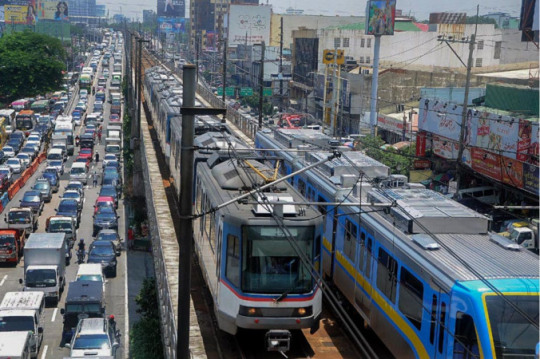
The major benefit of the LRT and MRT lines is the speed at which you can get from one part of Metro Manila to another. With Metro Manila comprising of 16 cities and the municipality of Pateros, this huge metropolis, known collectively as National Capital Region, covers an area of 619.5 km2. To complete the journey along EDSA by bus or car, from south to north, would normally take 4-5 hours, due to the immense volume of traffic.
The main drawback of the LRT and MRT lines is the crowded carriages. No matter what station you get on, chances are you will be standing the entire trip, and crushed up together with hundreds of other commuters.
Jeepney
The first jeepneys were modified army jeeps left behind by the Americans after WWII. They have been customised with Filipino touches such as chrome horses, banks of coloured headlights, radio antennae, paintings of the Virgin Mary and neon-coloured scenes from action comic books, as well as national flags and scenes from different countries, depending on the work location of the Overseas Filipino Worker (OFW) that paid for the jeepney.
Jeepneys form the main urban transport in most cities and complement the bus services between regional centres. The starting fare is usually P8, rising modestly for trips outside the primary distance allowed for that P8 fare. Routes are clearly written on the side of the jeepney, and signs in the windscreen show what locations the jeepney will pass through.
Jeepneys have a certain quirky, cultural appeal, but from a tourist’s perspective, they have one humongous flaw: you can barely see anything through the narrow open slats that pass as windows. The best seats are up front next to the driver.
Again, in most places, jeepneys can fill up fast, especially during rush hours, and sitting cramped with 10 other people on each side of the jeepney is normal. Drivers try to cram as many people in as possible, to get the maximum possible fare, and some passengers are even hanging on to the back, while standing on the step or the rear fender, although this is technically illegal. In more remote areas, it is common for jeepneys to have a roof full of passengers.
I have to say it, jeepneys are one of my favourite forms of public transport here, and I love to commute around the country. Although I can drive, I don’t like to here, and it’s much nicer to let someone else worry about the traffic while we watch the world go by through the small “windows”.
Traysikel
Found in most cities and towns, the traysikel (pronounced try-see-kell) is the Philippine rickshaw – a little, roofed sidecar bolted to a motorcycle. The standard fare for local trips in most provincial towns is P8, which goes up piso by piso the further you get from the pickup point. Traysikels that wait around in front of malls, restaurants and hotels will attempt to charge five to ten times that for a “special” trip, which is like hiring the whole vehicle. Avoid these by standing roadside and flagging down a passing P8 tricycle.
The general rule is, if you flag down a passing traysikel it is single fare only. And they will normally slow down to ask where you are going as they go past. If they don’t, it usually means they are going home or are probably not for hire. Travelling on a traysikel can also be done from a terminal. Just like buses and jeepneys, traysikels have terminals (or should if they are franchised, although some “colorum” traysikels just roam around without the correct plates or licenses picking up passengers along the way). A trip from the terminal, unless you ask for the “special” trip, will cost a single fare.
For example, if I get a traysikel from bayan to the house, it’s P13 if it’s shared. The “special” costs me P52, the price of four normal passengers. Prices can vary from terminal to terminal, so it’s best to always ask the fare before you ride. Traysikels are my other favourite form of public transport here, and the drivers work hard to make enough to feed their families, but they will rarely try and rip you off, even as foreign visitors. If the single fare in your shared traysikel is P8, that’s what you’ll pay.
You can also charter tricycles for about P300 per hour or P150 per 10km if you’re heading out of town.
Pedicabs
Many towns also have non-motorised push tricycles, alternately known as Pedicabs or padyak, for shorter trips. Padyak is a the Tagalog word for stomping or forcefully stepping, which is the action used by the drivers when they are pedaling a pedicab with passengers.
Fares are really cheap, sometimes as much as a few pesos less that traysikels, but they will only go short distances. Many open subdivisions (our kind of housing estate) have Pedicabs at the entrance, as well as dotted around inside, for resident’s convenience.
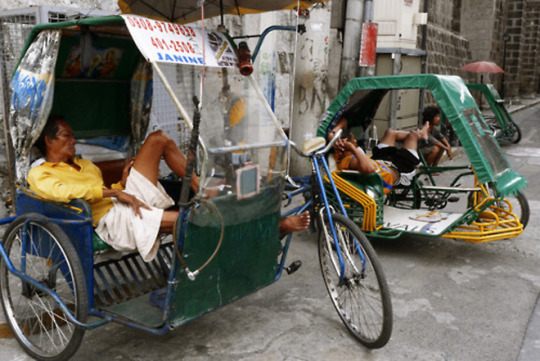
Habal-habal
In the mountain barangays or in the countryside where roads are steep and unpaved, Filipinos always find ways to make things faster and easier to navigate. So, motorcycles are turned into motor-taxis to replace carabaos as a mode of transport.
The normal motorcycle or motorbike is enough only for a passenger and a driver. However, the “habal-habal” motorcycle can carry 2 to 8 passengers (if installed with wooden wings). They are most common in the Visayas and northern Mindanao, although the motorcycle taxi is making inroads in Metro Manila in recent years, just taking only one passenger at a time.
ONLY IN MINDANAO. A motorcycle with 6 passengers ply the Pagalungan highway in Maguindanao province on June 8, 2012 MindaNews photo by Ruby Thursday More
In some areas in the Visayas and Mindanao, “habal-habal” is the term used to call a motorcycle-taxi where the driver and the passengers are in “habal” (animal) position. “Habal” is a Bisayan term that literally means “the sexual (act) intercourse of animals” but now, it seems like the meaning has evolved to mean the mode of transportation… probably due to the “intimate” way passengers are crammed together behind the driver.

Kalesa
A kalesa (also known as caritela or karitela) is a horse-drawn calash used in the Philippines. It was one mode of transportation introduced to the islands in the 18th century by the Spanish, and was initially reserved for only nobles and high-ranking civic officials. These are rarely used in the streets today, except in the tourist-frequented areas of old cities and some rural areas.
A kalesa looks like an inclined cart, and is drawn by a single horse. It has two round wheels on each side and two rows of seats that can accommodate four persons. The driver sits on a block of wood located at the front of the cart near the horse.
Although the kalesa has become a rarity, century-old examples are still preserved in areas of the Philippines, such as in Vigan and Laoag. Kalesas can also be found in Intramuros, where they cater to tourists and Binondo in Manila, as well as in Iligan, where decorated kalesas can be taken for a ride along a specific street. In Cagayan, kalesas are common, especially in Tuao and other municipalities of the province. In Tuguegarao, the carriages are a part of the traffic along with private cars, motorcycles, tricycles, jeepneys, trucks, and bicycles.
Bus & Van
Philippine buses come in all shapes and sizes. Bus depots are dotted throughout towns and the countryside, and most buses will stop if you wave them down. Bus “terminals” also run the gamut. Some are well-secured large garage-like structures with destinations clearly signposted and even ticket booths, whereas others are nothing more than a few run-down outdoor sheds with drivers clamouring for your business. I have even known some locally that are “terminals” in the car park of the local Jollibee or SM Mall.
More services run in the morning – buses on unsealed roads may only run in the morning, especially in remote areas. Night services, including deluxe 27-seaters, are common between Manila and major provincial hubs in Luzon, and in Mindanao.
In NCR, there are normally two kinds of buses. The air-conditioned buses, with closed windows and cool, have their refreshing AC running at close to freezing all the time, while the “ordinary” buses are open, old and amazingly fast. Whereas the AC buses run along the highways almost following the road rules, the “ordinary” buses, which have no air-con except the open windows and rust holes, race along at breathtaking speeds, changing lanes at the drop of a hat, and not slowing down for anyone or anything smaller than them.
While it is nice to ride the AC buses in the hotter weather here, the “ordinary” buses have more character, are cheaper, and often get you there faster, unless it is rush hour in Manila. They look and sound as if they are about to fall apart, but I’ve not ridden on one that has… yet! And when they are going at speed, the open windows give you a cooling breeze, even if it is smog-filled from traffic fumes.
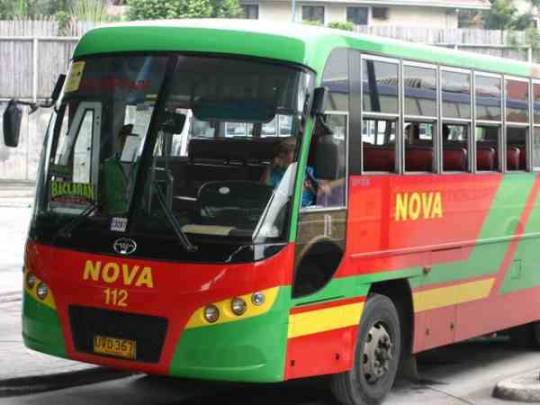
When riding the buses in Manila, especially the “ordinary” ones, be aware of the fares from place to place. It pays to listen to where the people around you are going, to know how much the ride will be, as the conductors will often add a little “surcharge” to foreigners who don’t know the fares. In more than a year of daily trips from Laguna to Makati, I was often told the fare was P10 more than it actually was.
Air-con minivans shadow bus routes in many parts of the Philippines (especially NCR, Bicol, Leyte, Cebu, Palawan and Mindanao) and in some cases have replaced buses altogether. However, you may have to play a waiting game until the vehicles are full. While they are a lot faster, they are not allowed to stop anywhere in Metro Manila, unlike the jeepneys, and there are many that are run illegally, with private use plates instead of commercial plates.
Door-to-door Service
As I mentioned earlier, the Philippines is the only place I know where you can go door-to-door without walking more than a few yards. And I said I would explain how, so here it is.
The best example is going from my house, inside a subdivision, to my wife’s tita (aunt) who lives in Parañaque, Metro Manila.
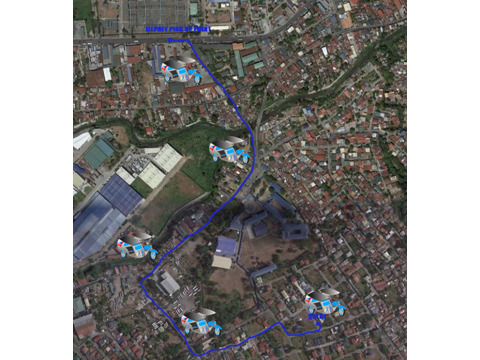
From my house, I can get a traysikel just outside the house to the main highway. Since I live inside a subdivision, a little village of sorts inside the city limits, traysikels often drop passengers off inside, and then go back out. Since they are often not part of the TODA (Traysikel Operators and Drivers Association) for that subdivision or barangay, they cannot go to the nearest terminal, and will pick up roadside passengers along the way, to maximize their income for the trip.
From where I get dropped on the highway, I can get a jeepney across the road to take me to Alabang, in Muntinlupa, which drops off inside Starmall.

The terminal for the buses going all over NCR is right outside, and I can get on one that says “Ayala Ibabaw” on the signs in the windscreen. Conductors are always touting for passengers, and will help with which bus you need to take for people who are not sure.
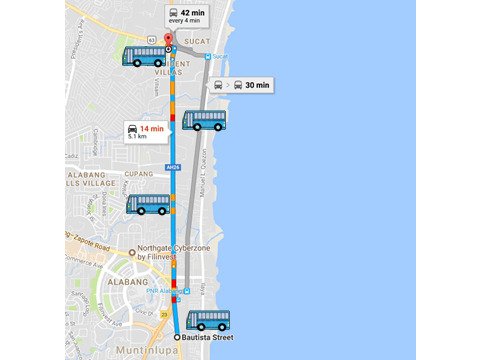
The bus route takes me all the way to Parañaque along SLEX (South Luzon Expressway) and Metro Manila Skyway, and drops off at the Sucat exit.

Cross the road, and I get a jeepney going to San Isidro, which is a single fare price of P8. Get down from the jeepney at the BPI Bank at Greenheights Ave, and cross the road, to the compound where my wife’s tita lives.
The return journey is much the same. A jeepney going past the road outside the compound will take me back down to the Sucat exit, where I can jump on the first bus back to San Pedro, Laguna. Both AC and “ordinary” buses run the route, and there are hundreds of them going that way looking for passengers. (Alternatively, I can get the bus back to Starmall, and do the journey exactly backwards, but I prefer to get a bus all the way to San Pedro.)
At San Pedro, a jeepney passing by can take me into bayan, and drops off around 20 yards from the traysikel terminal for my subdivision. Another P8 fare for this part of the trip.
From the terminal in bayan, the traysikel takes me back to the subdivision, as a shared ride for only P13, and I can direct the driver on which turns to take to get to my house, though since most of them know me from the terminal, I often don’t need to direct them.
What about the other passengers in the traysikel? Well, it’s the norm here for traysikels to carry rideshare passengers (see, we had rideshare and pool vehicles years before Uber!), and there is a courtesy to let the closest one out first, even if it means travelling through many streets to get to your own house after dropping them off.
Another thing that we have with the traysikels is service. Traysikel drivers are some of the nicest people you can meet here, and will gladly carry your shopping bags and sacks of rice to your door, and even inside (if you don’t have nasty, biting dogs like I have), for no extra charge.
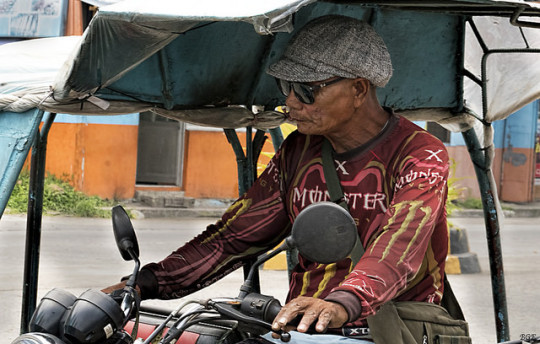
So, if you are thinking of coming to the Philippines, try to travel on the local public transport, and experience commuting the Filipino way. It really is “More Fun in the Philippines”.
Travel in the Philippines – Commuting like a Local Wherever you go around the world, you’re most likely to use public transport at some point. Once you get to the airport, taxis are normally the best option, especially if you have lots of heavy luggage.
#bus#calash#caritela#dolmus#door-to-door#habalhabal#jeep#jeepney#kalesa#karitela#LRT#MRT#ordinary#padyak#pedicab#Philippines#rail#taxi#travel#traysikel#tricycle#uber#UVExpress#van
0 notes